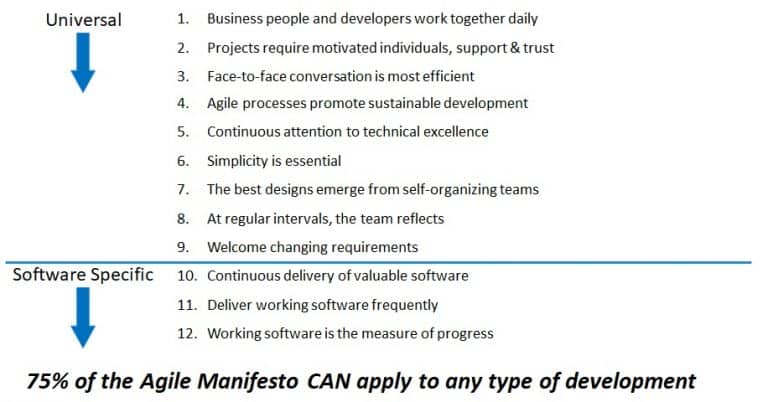Waterfall vs Agile?
“Agile and Waterfall methodologies are like oil and water. They don’t mix.”
“Software development differs from hardware; Agile only works for software.“
“Applying Agile is all or nothing.”
“You must be able to ship every two weeks.”
We constantly hear these statements from hardware teams trying to increase speed and predictability in their product development projects. The reality is that hybrid processes that mix the discipline and long-term planning of the Waterfall model with the adaptability and speed of Agile are not only possible – they are best-in-class.
Myths Hinder Adoption
The myths about Agile development generally come from those who aren’t students of the discipline but merely observers from the side. They’re correct that a rigid application of Agile software development process and techniques to a hardware development team would break down quickly. However, when modified for the unique hardware design and manufacturing characteristics, critical elements of Agile Product Development allow teams to gain the project management, speed, predictability, and product definition advantages that their software counterparts enjoy.

The Agile Manifesto – Not Just for Software
Our experience with clients, as well as our primary research, explodes the myth that Agile is all or nothing and that it is inapplicable to tangible products. The Agile manifesto refutes the notion that a Waterfall methodology and Agile are mutually exclusive.
Of the twelve Agile principles in the Manifesto, 75 percent are not specific to software development projects. For example, such concepts as “Business people and developers work together daily,”; “Projects require motivated individuals, support & trust,” or “Face-to-face conversation is most efficient” are not software specific. There’s no reason these agile software development principles cannot operate in any product development environment.
Significant differences exist between tangible products and software, but nothing prevents developers from importing select principles from Agile teams to other environments. Research we conducted showed that the use of sprints, having an iterative approach, and developing a local build capacity were used effectively by tangible product developers. Our experience with clients shows that selective use of tools from the Agile/Scrum toolbox is not only possible but also reduces team burnout, brings teams closer to customers, and improves the adaptability of product teams to shifts in markets or technologies throughout the product lifecycle. It’s not all or nothing.
Embedding Agile Within a Waterfall Methodology
Applying Agile methodology to hardware products does not have to be an “all or nothing” process. Suppose teams have a phase gate or milestone-based process. In that case, they can achieve the best results by applying modified agile methods within their current development process and project management methodology to yield an Agile Product Development Process.
The key to gaining this competitive advantage is to divide long product development timelines (12-18 months) into sprints, a tool frequently used in Agile software.
Then, nest these sprints within the Phase-Gate/Milestone framework. Using sprints within this larger framework accelerates decision-making. Sprints also divide a long journey into smaller steps, with concrete deliverables, within a fixed duration from two to four weeks. This division of the product development timeline into smaller units increases urgency and keeps the team on task. The results are less waste and faster product development timelines.

However, developing tangible products also requires the discipline and planning that Phase-Gate/Milestone processes afford. These longer-term cycles of planning provide the financial controls that concrete products need. Unlike many software products, the development phases for tangible products tend to involve numerous stakeholders: functions, partners, and suppliers. Unlike software, they often include dependencies such as tooling, material buys, and inventory control. Traditional waterfall methodology with gated processes also prevents budgets from ballooning out of control.
Regulatory or qualification cycles are also essential facets of the product plan for many products. For these reasons, tangible products require an end-to-end product plan with a comprehensive schedule to satisfy project requirements.
Adopt Agile Methodology Incrementally
At its heart, adopting Agile methodologies requires organizational change management. Adoption does not happen overnight; it does not occur quickly in large organizations. And it’s much more than adopting new project management software.
A proven approach is to pilot agile project management, using team members with a track record for embracing improvement. Organizations will learn quickly from pilot initiatives, and then they can improve in increments. Start with a clean slate, introducing your new methodology from the very beginning of the project.
Agile gurus and guidebooks are sometimes too rigid, imposing an orthodoxy that doesn’t make sense for your culture or products. Start small, learn the basics, and then improve by modifying the tools to fit your environment. Maybe it’s Gantt charts, kanban, project prioritization, end-user involvement, adding a more robust testing phase, or some other practice that works for you.
High-Performance Teams = the Secret Sauce
We’ve discovered that much of Agile’s success depends on high-performance teamwork. That means:
1) Upper management has empowered project teams to plan and prioritize their work;
2) Team members have both domain expertise and collaboration expertise that shows up in the final product;
3) Middle management changes their focus from micro-managing to removing roadblocks and
4) Everyone puts product allegiance over functional allegiance
High-performance teamwork requires a new way of working throughout the development lifecycle, but the most successful companies have mastered this challenge and are reaping the rewards. For others, high-performance teamwork is the gateway to entering the next phase of product development excellence.
Missed Opportunity
Many teams are losing an opportunity to accelerate the product development process because of unexamined assumptions about the Agile approach. The myths create one of the tallest barriers to adoption. Another hurdle is a lack of prescriptive best practices for adapting Agile principles to tangible products.
But changing minds and adapting what works is possible. It is necessary to stay ahead of the curve of product development speed. Companies that have mastered teamwork through every project phase are more than half there.
Another critical success factor is sprint planning. Define the sprints that are nested within your phase-gate process very carefully. Use short intervals and define each sprint’s goals, deliverables, and metrics with as much precision as possible.
Finally, give yourself an adequate timeframe to pilot and adopt Agile principles to your environment. Corporate culture plays a more significant role in tangible products, and change takes time. The culture must adapt to the fact that when you bring Agile tools to the job, functional managers must cede some of their control. Since teams that develop tangible products tend to be cross-functional, there are more functional managers, that is, more cooks in the kitchen. This can be a challenge when your team is trying to pilot workflows, sprints, product owners, agile testers, daily meetings, backlogs, and other Agile project management tools that help accelerate your teams. Again, your best approach is to learn the basics, start slowly, and adopt only what works for you.

